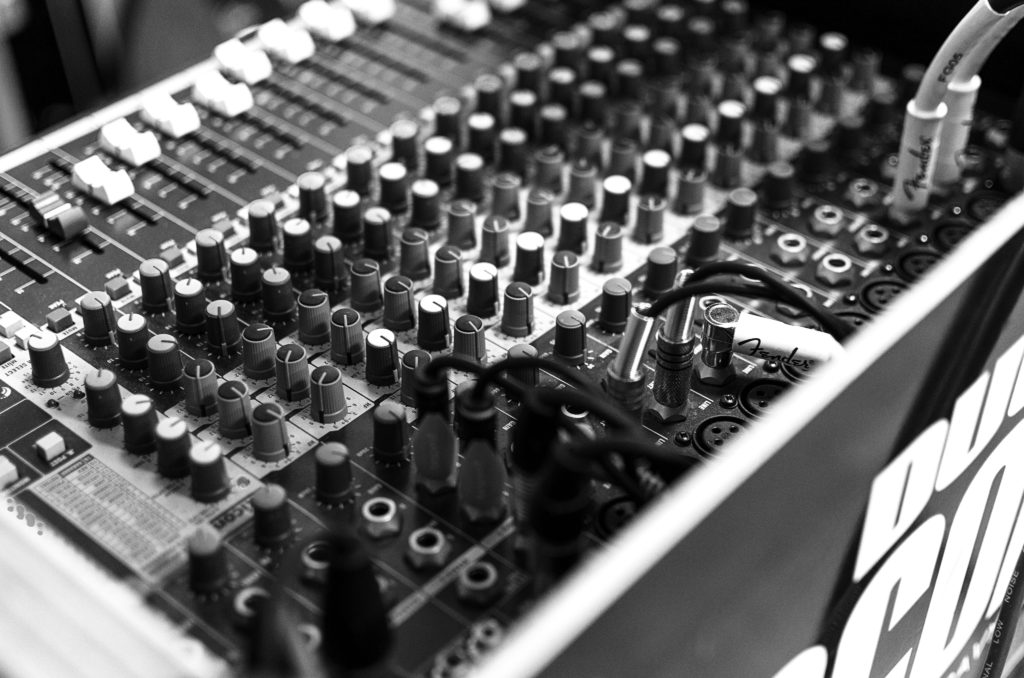Hissing is an unwanted yet common audio phenomenon characterized by a sustained “s” sound, similar to a snake hissing. Often caused by electronic interference, it can impact the quality of audio productions.

What is Hissing: Table of Contents
As we embark on this sonic journey through the complex landscape of audio production, one pervasive topic that echoes in the realms of sound engineering, recording studios, and even at the peaceful corners of a songwriter’s bedroom is the phenomenon of ‘hissing.’ But what exactly is hissing, and why should we care?
Hissing is that uninvited guest that often crashes your meticulously crafted sound party. It presents itself as a sustained, high-frequency noise, akin to the sound a snake might make, hence the term ‘hissing.’ But it’s not just the world of reptiles where hissing has a place. It plays a role in our daily lives, whether we are tuned into our favorite radio station, watching a movie, listening to our preferred Spotify playlist, or even during our own creative process of crafting a new musical piece.
However, in the realm of audio production and music, hissing often overstays its welcome, impacting the quality of the sound. That’s why understanding this unwelcome guest is so important. If we are ever to become master hosts in our world of sound, knowing who we’re inviting into our mix, including hissing, is crucial.
Hissing can slip into the most finely tuned pieces, obscuring the clarity of instruments, muffling the subtleties of vocal performances, and adding an overall grunge that might not be welcome. Being able to detect, manage, and in some cases, creatively use hissing, is a skill that underpins a successful audio production journey.
So let’s embark on this exploration of hissing together. It’s more than just an unwelcome noise; it’s a complex and captivating character in our audio narrative that requires understanding and management to ensure the story we’re telling through sound is clear, emotive, and of course, music to the listener’s ears.
What Does Hiss Mean in Audio Production?
In the vast sea of audio production, ‘hissing’ is like a persistent tide that, while often unnoticed by the untrained ear, can erode the quality of your sonic beach. But let’s break it down a little further.
In its simplest terms, hissing is a form of noise that registers at the higher frequencies. You can think of it as a constant, pervasive ‘ssss’ sound, not unlike the noise a snake or a deflating balloon would make. This sound is not limited to one or two specific frequencies but spans a broad spectrum, often most noticeable in the higher ranges.
The frequency spectrum is like a rainbow of sound, with the low, rumbling bass frequencies at one end, the bright, sharp treble frequencies at the other, and everything else in between. In this colorful palette of frequencies, hissing typically paints itself in the treble end of the spectrum, frequently manifesting between 6 kHz to 20 kHz. This range is the playground of cymbals, the sparkle in a singer’s voice, the sweet overtone of a strummed guitar, and yes, unfortunately, the hiss.
So why does hissing sound the alarm in audio production? Well, it’s a matter of balance and clarity. A little hissing noise may go unnoticed or might even add character to certain types of music. However, when it’s pervasive and loud, it can wash over your mix like a sonic sandstorm, obscuring the clarity of vocals, dulling the crispness of cymbals, or even worse, making your entire mix sound amateurish. The delicate balance of frequencies that allows each instrument and voice to shine in their own space becomes muddled. That’s why in audio production, keeping the uninvited hiss at bay is just as essential as tuning a guitar or setting the right tempo for a song. In the end, audio production is all about pristine sound, where every note, every voice, and every beat is a star. And there’s no room for a hissing sound to steal the limelight.

What Causes Hissing?
While hissing might appear to be a ghost-like entity, creeping into your tracks without a visible source, it is often rooted in very tangible causes. Let’s shine a spotlight on these culprits and understand how they manage to sneak that hissing sound into our recordings.
Electronic devices are like the orchestra of a recording setup, with each component playing its part in the harmony of sound production. However, just like an out-of-tune violin can spoil an orchestra’s performance, certain elements within your electronic devices can contribute to hissing. Every electronic device has an inherent noise floor, which is the minimum level of noise that a device produces. This is due to the random motions of electrons in the circuits, which lead to a form of noise known as thermal or Johnson noise. When amplified, this noise manifests as a hiss.
Next up on our culprit list is analog recording. While the nostalgic warmth of analog recordings can be musically charming, this charm often comes with a persistent shadow: tape hiss. The physical nature of tape and the magnetic particles used to capture sound inherently produces a level of noise. As the tape moves across the playback head, these minute inconsistencies in the magnetic particles result in a hissing sound. The golden era of reel-to-reel might be behind us, but for those who still engage with analog mediums, hiss is often a sidekick.
Digital signal processing (DSP), when done right, is the superhero of modern audio production, enabling everything from spectacular sonic effects to precision editing. However, when DSP is poorly executed, it can inadvertently contribute to hissing. Overzealous use of equalization boosts, extreme compression settings, or heavy digital gain staging can all exacerbate the inherent noise floor of your audio, raising the hiss level to an audible and distracting prominence. While DSP gives us near-limitless creative freedom, like any powerful tool, it requires a careful and skilled hand.
Unraveling the sources of hissing enables us to take proactive steps to manage, reduce, and sometimes eliminate this unwanted sound. By understanding how our equipment, recording mediums, and processing techniques can contribute to hiss, we’re empowered to make more informed choices in our pursuit of audio excellence.
How Do Microphones Contribute to Hissing?
The microphone – the faithful messenger of sound, picking up every nuance of a vocalist’s performance, every detail of an instrument’s voice. However, this faithful ally can also act as a gatekeeper for hissing. Let’s dig into how microphones contribute to hissing and common issues that can lead to it.
At its core, a microphone is an incredibly sensitive device. Its sole purpose is to convert the physical vibrations of sound into electrical signals. However, in doing so, it doesn’t discriminate between the desired sound and any accompanying noise, including hiss. Every microphone, regardless of quality, has an inherent self-noise, also known as the equivalent noise level (ENL). This noise, while typically low, can manifest as a hiss in your recordings, especially when amplified.
One common microphone issue that can lead to hissing is poor gain staging. Gain refers to the amplification of the mic’s signal, and proper gain staging is key to capturing a clean recording. If the gain is set too low, the signal may be weak, and boosting it in your audio software will simultaneously boost the microphone’s self-noise, including the hiss. Conversely, if the gain is too high, the mic can clip, leading to distortion and a possible increase in perceived hiss.
Another issue is the use of low-quality cables or poor connections, which can introduce electrical interference, or ‘noise.’ This interference often appears as a pervasive hiss in your audio.
Microphone placement can also play a part in unintentional hissing. If the mic is placed too close to a noise source (like a computer fan or an air conditioner), it might pick up this ambient noise, which often includes a hissing component.
Understanding how microphones contribute to hissing helps us take preventative measures. By choosing low-noise mics, maintaining proper gain staging, using quality cables, and practicing mindful mic placement, we can keep the hiss at bay, ensuring that our microphone remains a trusty ally in our audio journey, rather than an inadvertent saboteur.
Hissing vs. Humming and Buzzing: What’s the Difference?
When we delve into the nuanced world of audio production, we encounter a veritable zoo of unwanted noise creatures. Among them, hissing, humming, and buzzing are some of the most common, but each carries its unique signature and origin. So, how do we differentiate between these sonic interlopers?
Humming and buzzing, although sometimes used interchangeably, are unique in their characteristics. A hum usually presents itself as a continuous, low-frequency drone, much like the sound of a distant lawn mower or the drone of a refrigerator. In the context of audio production, this often originates from power supply issues, or what’s known as ground loops. A ground loop is an unwanted current in a conductor connecting two points that are supposed to be at the same potential, often earth ground, but are actually at different potentials. It often manifests in a distinct hum at the frequency of the electrical power supply, typically 50 or 60 Hz depending on your region.
Buzzing, on the other hand, is a bit of a sonic rebel. It generally involves higher frequencies than a hum and is more erratic, much like the unpredictable, chaotic noise of an insect swarm. This can result from a variety of issues, including faulty cables, poor shielding, or electronic interference from nearby devices.
Hissing differs from both humming and buzzing. It occupies a higher frequency spectrum and is often continuous, like the sound of air escaping from a tire or a snake in the grass. As we’ve explored, it can originate from a variety of sources, including inherent noise in electronic devices, analog tape recordings, poorly executed digital signal processing, and microphone-related issues.
Each of these audio annoyances carries its unique signature in terms of frequency and behavior, and they stem from different issues within your audio setup. By understanding the differences, we can better identify and address the specific causes, leading to cleaner, higher-quality audio. We might not be able to entirely eliminate these unwanted guests from our audio party, but we can certainly ensure they don’t outstay their welcome.
What Are Some Techniques for Removing Hiss From Audio?
While hissing can sometimes feel like an unwelcome squatter in our audio tracks, the good news is that there are several ways to show it the exit. From preventive steps in the recording phase to post-production noise reduction tools, let’s explore how we can mitigate and remove hissing from our audio.
First, prevention is often better than a cure. A key preventive step is proper gain staging. This refers to managing the levels of your audio signal at each point in your signal path, from your microphone to your recording software. By setting your gain appropriately, you ensure that the signal is strong enough to be above the noise floor (including the hiss) but not so high that it distorts. Remember, boosting a weak signal in post-production can also boost the hiss, so try to capture the cleanest, strongest signal you can at the source.
Using high-quality cables and keeping your workspace as quiet as possible also helps. Electromagnetic interference from low-quality cables or ambient noise from computer fans, air conditioners, or even traffic outside your window can all contribute to the hiss. Mitigate these where you can.
Now, what if the hiss is already there? Enter the realm of post-production noise reduction. Most digital audio workstations (DAWs) come equipped with noise reduction plugins, which can be a lifesaver. Here’s a simple guide:
- Find a ‘quiet’ section of your track where only the hiss is present.
- Use your noise reduction plugin’s ‘learn’ function (if available) to capture the noise profile. This helps the plugin understand what it needs to remove.
- Apply the noise reduction to the entire track. It’s often best to start with a light setting and gradually increase the reduction until the hiss is minimally perceptible.
These plugins work by reducing the volume of the frequencies where the hiss resides, based on the noise profile you provided. However, use them sparingly, as aggressive noise reduction can lead to unwanted artifacts or a ‘tinny’ sound.
Lastly, consider using a high-pass filter. Since hissing occupies the higher frequencies, a high-pass filter can help reduce it without affecting the lower frequencies. But again, use this with care, as it can also affect the high-frequency components of your desired sound.
Removing hiss is often a balancing act between reducing unwanted noise and maintaining audio quality. But with these techniques and a little patience, you can certainly bring the hiss down to a whisper, leaving the stage clear for your intended audio to shine.
Can Hissing be Used Creatively in Audio Production?
In the vast universe of sound, hissing, often seen as a disruptive force, can actually find its place as a creative tool under the right circumstances. After all, music and sound design are art forms, and sometimes, the imperfections, the noise, and the grit, can bring a unique texture that resonates with the aesthetic of the piece. Let’s discover how hissing can take up this creative mantle in certain music genres and examples of its artistic use.
There’s an intriguing charm in some genres like Lo-Fi Hip-Hop, Vaporwave, or Ambient music where hissing, instead of being an intruder, becomes an integral part of the soundscape. It delivers an organic, nostalgic warmth, invoking a sense of comforting imperfection that contrasts with the often sterile, digital precision of modern productions. This hiss, sometimes layered in deliberately, emulates the texture of vintage analog recordings, imbuing the track with an old-school charm.
In film scoring and sound design, hissing can serve as a useful tool to create specific atmospheres or convey certain emotions. The subtle hiss of an old radio, the atmospheric hiss of a gusty wind, or the eerie hiss that precedes a suspenseful moment can enhance the auditory experience and support the narrative.
Practical Tips to Prevent and Reduce Hissing
Even though we’ve established that hissing can sometimes add artistic value, more often than not, we’re looking to reduce it. Here, we’re going to dive into some hands-on, practical tips that will help you take the reins and navigate your way through the hissy territory of audio production.
To start with, invest in quality equipment. Just as a painter’s brush influences their strokes, your audio equipment plays a significant role in the quality of your sound. High-quality microphones, cables, and audio interfaces often have lower noise floors, which means less inherent hiss to deal with. It’s an investment that pays dividends in your final sound.
Secondly, get your gain staging right. Think of your audio signal as a passenger on a journey from your instrument to your recording software. At every stage of this journey (the microphone, the cable, the preamp, the audio interface, etc.), the signal can be amplified or attenuated – this is ‘gain staging. If your gain is too low at the initial stages (microphone, preamp), you’ll have a weak signal buried in noise, which will get amplified when you try to boost it later, leading to noticeable hiss. So, aim for a strong, clean signal right from the source.
Also, keep your signal path as clean and uncluttered as possible. Every piece of equipment or processing your signal goes through adds a little bit of noise. This is especially true for digital signal processing (DSP). While DSP can work magic on your sound, it can also introduce or exacerbate hissing if not used correctly. So, use DSP sparingly and always monitor the effect on your noise levels.
Finally, maintain a quiet recording environment. The sound of your computer fan, the air conditioning, or even the traffic outside can all contribute to hissing. Aim for a well-treated, quiet space for recording.
In summary, preventing and reducing hiss is a matter of careful gain staging, using quality equipment, minimizing unnecessary DSP, and maintaining a quiet recording environment. With these tips in your arsenal, you’ll be well on your way to crisp, clean sound. Remember, audio production is a journey of constant learning and refinement. So, keep experimenting, keep learning, and above all, keep listening.
The Last Hiss: Summarizing Our Sonic Journey
As we pull back from our deep dive into the world of hissing, it’s evident that this pervasive phenomenon, often deemed an audio nuisance, carries more dimensions than one might initially perceive. Hissing, despite being a challenge, is part of the broader canvas of sound that we, as audio enthusiasts, navigate each time we hit the record button.
While the technical aspects of hissing, its causes, and its remedies, are critical, understanding its potential as a creative tool has its place in our audio toolkit too. Be it the warmth it adds to a Lo-Fi track or the atmospheric depth in a film score, hissing can be an ally when used with intent and understanding.
With the practical tips we’ve covered, remember that prevention is often the best cure. Gain staging, quality equipment, and a quiet recording environment are your first line of defense against unwanted noise. In the post-production stage, noise reduction tools and filters can be powerful allies, but like any tool, they need to be used with care and precision.
This journey into hissing serves as a reminder that audio production is a beautifully complex field, filled with challenges to overcome and discoveries to make. It’s a space where science and creativity collide, and often, it’s in these collisions that the magic happens.
So, keep exploring, keep experimenting, and above all, keep listening. The world of audio production is a rich sonic landscape with endless territories to chart, and every challenge, including hissing, is a step towards mastering your craft. As you delve deeper, may your ears guide you, your curiosity drive you, and may the hisses, hums, and buzzes be your guides, not your obstacles. After all, every sound has a story. Happy recording!

Unraveling the Hiss: Frequently Asked Questions
As we demystify the concept of hissing in audio production, there might be lingering questions or certain areas that require a little more clarity. This is a vast field, after all, and every new concept opens the door to more inquiries. So, let’s delve into some of the most commonly asked questions on this subject, addressing the nuances, the how-tos, and the why-nots that often pop up when we talk about hissing in audio production.
What does a hiss sound like?
A hiss typically sounds like a continuous, high-frequency noise, similar to the sound of steam or a deflating balloon. It’s often background noise that you might not notice until it’s absent.
Is hiss in audio always bad?
Not necessarily. While generally seen as undesirable, some genres of music or sound design may use hiss as a creative element to add texture or convey certain moods or feelings.
Can you eliminate hiss completely?
While you can significantly reduce hiss, completely eliminating it may not be possible due to the inherent noise floor of your equipment and recording environment. However, with proper techniques, it can be minimized to an unnoticeable level.
What is a noise floor?
The noise floor refers to the sum of all the unwanted signals (noise) that a system produces. In audio production, it includes hiss and any other electrical or ambient noises in the signal chain.
What is gain staging?
Gain staging is the process of managing the levels of your audio signal at every stage in your signal chain, from the initial recording to the final output, to prevent distortion and noise, including hiss.
How does the quality of my equipment affect hiss?
Higher-quality audio equipment usually has a lower noise floor, meaning it produces less inherent hiss and other types of noise.
Why does hiss occur more in analog recordings?
Analog equipment tends to introduce more noise, including hiss, due to the physical nature of how the sound is recorded and played back. This is less of a problem with digital recording, though digital systems have their own types of noise.
Can digital signal processing (DSP) cause hiss?
DSP itself doesn’t cause hiss, but it can amplify existing noise if not used correctly. This is why it’s important to use high-quality plugins and to be cautious of over-processing.
What kind of software can I use to reduce hiss?
There are numerous noise reduction plugins that can help reduce hiss, such as iZotope RX, Waves X-Noise, or Adobe Audition’s Noise Reduction effect.
What’s the difference between passive and active hiss removal?
Passive hiss removal refers to methods to prevent or reduce hiss at the source, like using quality equipment and good gain staging. Active removal involves using software to remove hiss after recording.
What’s a high-pass filter and can it help with hiss?
A high-pass filter lets high-frequency sounds through while reducing low frequencies. As hiss is a high-frequency noise, a high-pass filter would not typically help reduce hiss.
What does a de-esser do and can it help with hiss?
A de-esser reduces sibilant sounds (like “s” or “sh”) in vocal recordings. While not specifically designed to reduce hiss, it may help if the hiss is in the same frequency range as the sibilance.
Is tape hiss the same as the hiss in digital recordings?
Tape hiss is a specific type of hiss caused by the physical nature of tape recordings. It’s a form of analog noise and is not present in digital recordings unless added intentionally.
What’s the difference between white noise and hiss?
White noise is a type of noise that has equal intensity at every frequency. Hiss is often considered a type of white noise, but in a specific high-frequency range.
Does higher sample rate mean less hiss?
Not necessarily. While a higher sample rate can improve the overall clarity and detail of a recording, it does not inherently reduce hiss or other noise.
Is there a difference between hiss and static?
Static can refer to a range of unwanted noises in a signal, whereas hiss refers specifically to a continuous, high-frequency noise.
Can you describe what hiss sounds like in music?
In music, hiss can add a subtle layer of noise in the background. Depending on its intensity, it might create a “warm” or vintage sound, or it could be distracting and undesirable.
Does bit depth affect hiss?
Higher bit depths can increase the dynamic range of a recording, which might help minimize hiss relative to the sounds you want to capture.
What’s the difference between noise and hiss?
Noise is a broad term that refers to any unwanted sound in a signal. Hiss is a specific type of noise characterized by its continuous, high-frequency nature.
Why do old recordings have more hiss?
Old analog recordings often have more hiss due to the physical nature of how the sound was captured and reproduced, as well as the limitations of the equipment used at the time.
Can room acoustics affect hiss?
Room acoustics don’t directly create hiss, but a noisy or echoey room can increase the overall noise floor when recording, which might result in more hiss being captured.

